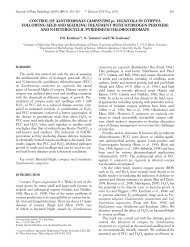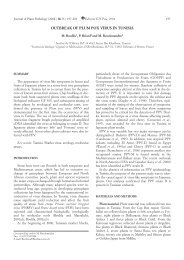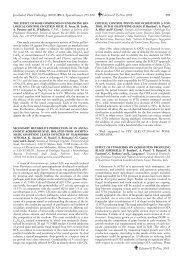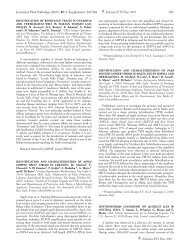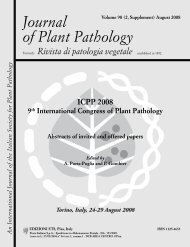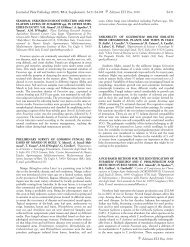Journal of Plant Pathology - Sipav.org
Journal of Plant Pathology - Sipav.org
Journal of Plant Pathology - Sipav.org
Create successful ePaper yourself
Turn your PDF publications into a flip-book with our unique Google optimized e-Paper software.
<strong>Journal</strong> <strong>of</strong> <strong>Plant</strong> <strong>Pathology</strong> (2011), 93 (1, Supplement), S1.19-S1.26 S1.21<br />
FUSARIUM HEAD BLIGHT OF BARLEY. A. Linkmeyer, M.<br />
Heß, R. Hückelhoven and H. Hausladen. Lehrstuhl für Phytopathologie,<br />
Technische Universität Weihenstephan, Germany. E-<br />
mail: a.linkmeyer@wzw.tum.de<br />
Fusarium head blight (FHB) is a widespread fungal disease <strong>of</strong><br />
cereals including wheat (Triticum spp.) and barley (Hordeum vulgare),<br />
caused by different species <strong>of</strong> the genus Fusarium. Apart<br />
from direct yield losses, the most serious concern is the contamination<br />
<strong>of</strong> the grain with mycotoxins. In Germany, FHB is predominantly<br />
associated with wheat, F. graminearum and F. culmorum<br />
being the most common species. In recent years, an enhanced<br />
incidence <strong>of</strong> FHB was also observed in German barley<br />
crops. Fusarium-infested grains are not acceptable as raw material<br />
for malting and brewing industry. We carried out monitoring<br />
studies in Bavaria, the main region for malting barley production<br />
in Germany. These studies indicated an infestation situation different<br />
from that known for wheat. A large number <strong>of</strong> different<br />
Fusarium species was observed all over Bavaria, including F. avenaceum,<br />
F. culmorum, F. graminearum, F. langsethiae, F. poae, F.<br />
sporotrichioides and F. tricinctum. These species produce a wide<br />
range <strong>of</strong> different mycotoxins such as type A trichothecenes (T2;<br />
HT2), type B trichothecenes (deoxynivalenol, DON; nivalenol),<br />
zearalenon (ZEA), moniliformin, enniatins and beauvericins. It<br />
seems that the classical DON-producing species F. graminearum<br />
and F. culmorum occur less <strong>of</strong>ten in barley, whereas type A trichothecene-<br />
producing species such as F. sporotrichioides, F. poae<br />
and F. langsethiae are more frequent. Infestation with Fusarium<br />
in general, and the occurrence <strong>of</strong> different species were highly<br />
dependent on environmental conditions and geographical location.<br />
This shift in the spectrum <strong>of</strong> Fusarium species compared to<br />
wheat does have consequences for the mycotoxins produced.<br />
Standardized techniques for toxin measurements and threshold<br />
values exist for DON and ZEA, the most prevalent mycotoxins<br />
in wheat. but not for the determination <strong>of</strong> relevant toxins in barley,<br />
especially for the type A trichothecenes T2 and HT2. Further<br />
questions addressed are the consequences <strong>of</strong> this shift in the<br />
spectrum <strong>of</strong> Fusarium species on pathology, epidemiology, hostparasite<br />
interaction as well as on possibilities <strong>of</strong> disease control.<br />
Inoculation experiments were carried out to investigate the impact<br />
<strong>of</strong> different Fusarium species on the pathology, grain infestation<br />
and mycotoxin contamination <strong>of</strong> barley. Whereas artificial<br />
inoculations with F. culmorum and F. avenaceum at anthesis resulted<br />
in strong symptom expression, inoculation with F.<br />
sporotrichioides, F. langsethiae, F. poae and F. tricinctum did not.<br />
Symptoms caused by F. culmorum were in agreement with high<br />
levels <strong>of</strong> fungal DNA (qPCR) and DON contamination (LC-MS/<br />
MS) in grains. In contrast, infestation with F. sporotrichioides was<br />
hardly detectable by visual assessments and qPCR after inoculation,<br />
but resulted in high levels <strong>of</strong> T2 and HT2 in the grains. Additionally,<br />
in competition with other species, F. sporotrichioides<br />
caused high mycotoxin contaminations, even though this species<br />
is described as a weak pathogen with low impact on FHB. Inoculation<br />
with a mixture <strong>of</strong> the Fusarium species mentioned above<br />
resulted in high levels <strong>of</strong> DON as well as <strong>of</strong> T2 and HT2. These<br />
results indicate that there are great difficulties to estimate risks <strong>of</strong><br />
mycotoxin contaminations based on visual assessments <strong>of</strong> the<br />
growth <strong>of</strong> Fusarium sp. on barley grains. Further studies are<br />
needed to better understand the impact <strong>of</strong> the different species<br />
on FHB in barley.<br />
delle Piante - Unità di Ricerca Istituto Nazionale Biostrutture e<br />
Biosistemi, Università degli Studi, Via E. De Nicola 9, 07100 Sassari,<br />
Italy. E-mail: qmigheli@uniss.it<br />
In 2009, the United Nations estimated the human population<br />
to reach 7,000,000,000 people in 2011. Current projections indicate<br />
that between the years 2040 and 2050, the world population<br />
is expected to range from 8 to 10.5 billion. This sudden increase<br />
over the course <strong>of</strong> the last two centuries raises serious concern<br />
about how longer an overpopulated earth will be able to sustain<br />
multiple threats to its ecosystems, such as rising levels <strong>of</strong> carbon<br />
dioxide, global warming, chemical and radioactive pollution, and<br />
the progressive erosion <strong>of</strong> biodiversity. Under these circumstances,<br />
there is a need to increase the production <strong>of</strong> high-quality<br />
food by reducing agricultural inputs, including water, pesticides<br />
and farmland areas, an accomplishment that appears particularly<br />
challenging if we consider the ongoing global environmental<br />
change. <strong>Plant</strong> pathogens are most effective self-evolving threats to<br />
food quality. Filamentous fungi are able to deteriorate fruit, vegetable<br />
and grain commodities during the post-harvest management<br />
stages. An increasing array <strong>of</strong> species, mainly belonging to<br />
the genera Aspergillus, Penicillium and Fusarium, is reported to<br />
be responsible for the contamination <strong>of</strong> food and feed with mycotoxins.<br />
Crops in tropical and subtropical latitudes are more<br />
prone to contamination than those grown or stored in temperate<br />
areas, due to the presence <strong>of</strong> environmental and management<br />
conditions (temperature, humidity, improper storage) that are<br />
most suitable for infection and, hence, mycotoxin formation.<br />
With this respect, the increasing demand for <strong>org</strong>anically grown<br />
food, which is commonly perceived as a healthier and safer alternative<br />
to conventional food by spoiled and hyper-nourished western<br />
consumers, calls into the question whether “<strong>org</strong>anic” should<br />
be really considered as a synonym <strong>of</strong> “safe”. Among the most<br />
bioactive secondary metabolites, aflatoxins, ochratoxins, fumonisins,<br />
zearalenone, patulin, and trichothecenes are now considered<br />
<strong>of</strong> worldwide public health importance. In both the USA<br />
and Europe, there are now strictly enforced limits as to the concentration<br />
<strong>of</strong> mycotoxins permitted in unprocessed plant products<br />
as well as in processed foods and animal feed. Control <strong>of</strong><br />
mycotoxin contamination below acceptable levels can only be<br />
achieved by an integrated approach, which should be based on:<br />
(i) adoption <strong>of</strong> suitable agronomic measures and epidemiological<br />
schemes; (ii) sound application <strong>of</strong> effective fungicides (and, in<br />
some instances, insecticides); (iii) use <strong>of</strong> environmentally safe and<br />
economically sustainable biological control agents; (iv) development<br />
<strong>of</strong> sensitive, fast, reliable, and possibly cheap diagnostic/analytical<br />
methods; (v) selection <strong>of</strong> resistant varieties, which should<br />
minimize the risk <strong>of</strong> mycotoxin contamination. Thus, there is a<br />
growing need for new molecules targeted at the secondary metabolic<br />
pathways; for biological control agents able to specifically<br />
interact with mycotoxin-producing fungi; for user-friendly diagnostic<br />
methods that should be integrated into a more complex<br />
risk assessment framework; and for selection strategies aimed at<br />
retrieving resistant or tolerant plant germplasm from wild relatives.<br />
Molecular biology tools are being developed to assist the research<br />
along each one <strong>of</strong> these converging pathways, and most<br />
relevant examples will be summarised.<br />
*<br />
Invited keynote lecture<br />
FOOD QUALITY IMPROVEMENT BY POST HARVEST<br />
MANAGEMENT AND MOLECULAR BIOLOGY TOOLS * .<br />
V. Balmas, L. Cogotzi, S. Fiori, A. Marcello, M. Orrù, B.<br />
Scherm, F. Spanu and Q. Migheli. Dipartimento di Protezione<br />
DETECTION AND QUANTIFICATION OF PECTOBAC-<br />
TERIUM ATROSEPTICUM DIRECTLY FROM DISEASED<br />
AND ASYMPTOMATIC TISSUES: A STUDY IN<br />
PATHOGEN TESTING USING ISOTHERMAL DNA AM-<br />
PLIFICATION. D. Lee, H. Jones, A. Kretzschmar, J. Thomas



